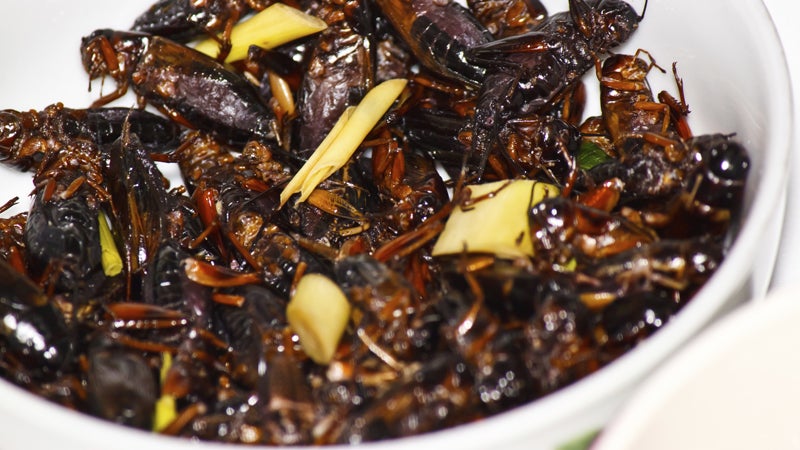A widely available, dirt-cheap, eco-friendly superfood that has more protein density per bite than beef and is chock-full of vitamins and minerals? Look no farther than the crickets in your backyard.
Cricket Nutrition
Per 100 grams of cricketsProtein: 16 to 21 g
Carbohydrates: 5.1 g
Calcium: 75.8 mg
Phosphorous: 185.3 mg
Iron: 9.5 mg
That’s right. Those critters chirping away in your vegetable garden are more than suitable for human consumption, and with 16 to 21 grams of protein per 100 grams of cricket, the little brown bugs make for a great post- or pre-workout snack.
It’s a “no-brainer,” says , an entomologist with the Audubon Nature Institute. Crickets provide more than enough protein to fuel the rest of your day. “And they contain a good, but not excessive, amount of fat and carbohydrate,” he adds.
A hundred grams of cricket contains only about 5 grams of fat and 121 calories. For comparision, a hundred grams of beef has close to 300 calories and 20 grams of fat. Although a hundred grams of ground beef has more protein (26 grams) than the equivalent amount of cricket, the nutritional quality of bovine protein is lower.
The little fat crickets do have is the good kind, unlike the cholesterol-raising fat found in beef and pork. Brooklyn-based Exo and San Francisco company Bitty Foods were quick to hop on these insects’ fitness-boosting potential early on. Both businesses offer cricket-flour energy bars in non-insect-evoking flavors like cashew-ginger and cacao nut. A uniquely low-impact and convenient form of cultivating high-protein food, cricket farms can fit in a bedroom closet or garage and require minimal effort and investment.
Sure, you can buy crickets at a store, but the ones you’ll find weren’t raised for human consumption. Store-bought crickets are usually given artificial feed, which isn’t produced with the human digestive system in mind. Farming your own herd gives you a degree of quality control you won’t find in the local pet store. And if crickets become a regular part of your diet, breeding them yourself will be cost-efficient.
For those of you who can get past our culture’s bug-munching taboos, what follows is a guide for starting and maintaining your own cricket farm.
Step One: Preparation
Get a high-sided, 14-gallon bin—this will hold 500 crickets, which are more than enough for starting out. Make sure the bin’s walls are smooth (so the crickets can’t hop over them and escape), and check that there’s proper ventilation (so the insects can breathe). Because they’ll need a constant source of water, provide a water tray that’s shallow enough that they can’t drown, or .
Step Two: Starting Out
You can purchase your crickets in bulk at a pet store or . They’ll cost about a dime each. Put them in the bin and make sure they’re kept at a regular temperature of about 86 degrees.
Feed the adults plants like cucumber, morning glory, and pumpkin. What you feed them can affect how they taste, so feel free to experiment. Robert Nathan Allen of , an Austin-based nonprofit dedicated to inspiring more insect-eating, explains: “Feed them mint, and they’ll taste minty; feed them apple and cinnamon, and they’ll taste like apple and cinnamon.” Make sure there are no pesticides in what you give your crickets (the chemicals would kill them), and check their food regularly for mold as well.
Step Three: Breeding
Get a small tray and fill it a few inches with clean topsoil: this is where the females will lay their eggs. The environment must be kept moist, so spray it every day. Once they’ve been laid, you’ll be able to see the eggs—they resemble little grains of saffron rice poking out of the soil. Next, remove the tray and keep it incubated in a hot, humid climate (90 percent relative humidity), until the babies hatch (within 7 to 10 days). Be aware that the eggs won’t hatch if they aren’t kept warm. You can use a heat lamp or a heating pad for this—and make sure to spray the soil with water every day.
The babies, which will be about the size of a pinhead, need to be kept in a separate container until they’re big enough for the main farm. Feed them high-protein foods like tofu and chicken, and they’ll grow quickly. In about a month, they’ll reach full size; a few weeks later, they’ll be ready to breed.
According to Andrew Brentano, cofounder of , a company focused on building the world’s first open-source edible-bug-farming kit, there are five basics for successfully cultivating crickets:
- clean food and water
- sufficiently fresh air flow
- a consistent temperature of 86 degrees
- 90 percent relative humidity for the first week or two of life, followed by less than 50 percent humidity
- enough space so the growing crickets can spread out and exist comfortably
Once you’ve mastered these steps (which won’t take long), simply keep the system in rotation. Before you know it, you’ll be a full-fledged cricket farmer. Harvest your crop, then boil it in rolling water and sauté with some salt, basil, and olive oil for a tasty snack that’s loaded with protein and good fats.


